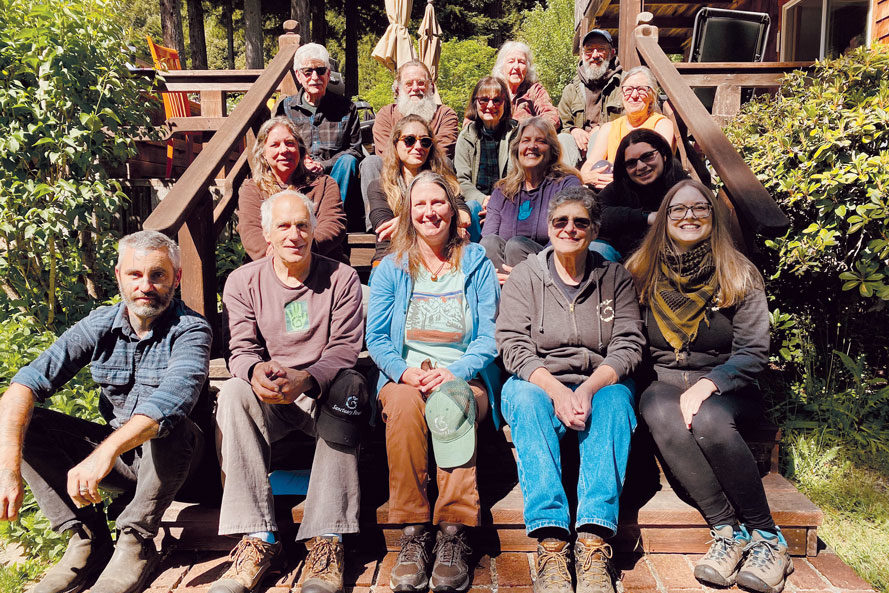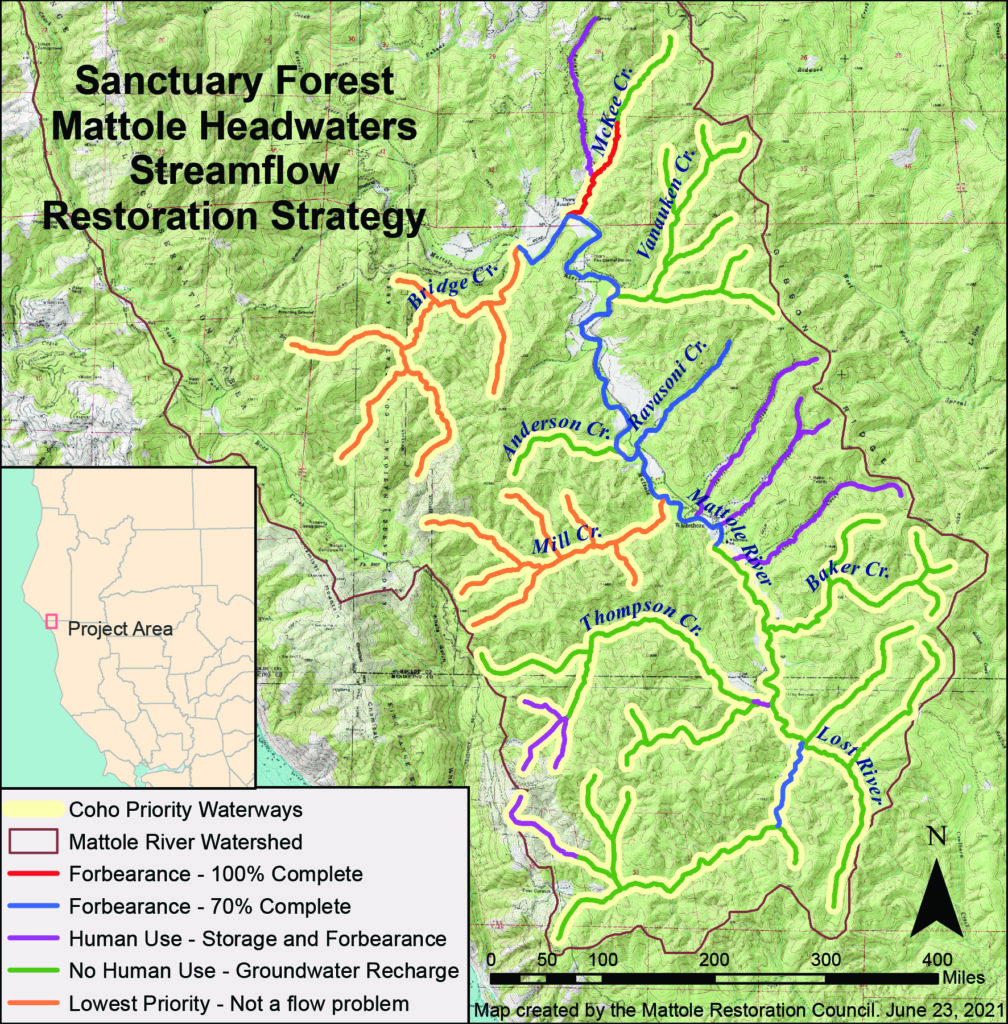Then & Now! Sanctuary Forest

A Few of Our Partners Revisit Projects From Years Past and Share Where They Stand Today
Then
From Trees Foundation’s Branching Out, Winter 2007
Sanctuary Forest’s Mattole Flow Program continues to lead the way for our community and the land trust movement in the area of rural water conservation and protection of instream flows. The goal of the Mattole Flow Program is to maintain healthy instream flows for fish and people during the critical dry season. Since 2000 the Mattole watershed and many other North Coast rivers have experienced a prolonged pattern of extreme low stream flows threatening the survival of endangered salmonids and the water supply of rural communities.
This summer the Mattole Flow Program reached a major milestone with installation of the first two of what will be a total of eighteen large capacity water storage tanks installed in the Mattole headwaters. Participating landowners who receive these tanks enter into binding long term legal agreements not to pump from the river during the critical low flow season. Participants use the stored water instead, maintaining water in the river when fish need it the most. This program of “storage and forbearance” addresses the fact that human use accounts for 20-80% of the headwater’s flows depending on the severity of the dry season. Through installation of these tanks Sanctuary Forest expects to make significant improvements to summer flows in two critical salmon habitat reaches of the river that now normally run dry.
Monitoring the river’s flow and continuing to study the causes, effects and potential solutions to the low flow crisis are important aspects of the Mattole Flow Program. Two such studies initiated this past spring and summer included a salmon survival study and a ground water monitoring study.
Despite the obvious connection there is little scientific literature on the survival of salmon under low flow conditions. For this reason Sanctuary Forest initiated a fish survival study in collaboration with UC Berkeley graduate student Ted Grantham and the Mattole Salmon Group. This study made repeated population counts of fish throughout the dry season, documenting mortality under various habitat conditions. Up until now we could only speculate on how many fish are lost because of the low flows. Through continuation of this study we hope to demonstrate the ongoing need and effectiveness of the Mattole Flow Program in restoration of native salmon.

Sanctuary Forest has been monitoring stream flows in the Mattole headwaters each summer season since 2004. What‘s new for 2007 was the beginning of our program to monitor the flows of groundwater. Like the relationship between a tree and its roots, you cannot understand a river without studying what happens to the vast amount of water stored underground in soil and rock. Preliminary ground water monitoring indicates ground and surface water in the Mattole are very connected and that summer instream flows are highly dependent on the flow of ground water. For this reason Sanctuary Forest is preparing a ground water management plan for the Mattole River headwaters and studying the potential to help increase summer flows through ground water recharge projects.
Sanctuary Forest recognizes the importance of water to maintaining the health of our forest ecosystem. Through the Mattole Flow Program we are making significant strides in addressing our own low flow problem as well as developing innovative tools that other communities and land trusts can use in addressing the widespread need for water conservation.
In recognition of Sanctuary Forest’s innovations as a land trust working in the area of water conservation, we were invited to make presentations about the Mattole Flow Program to the California Council of Land Trusts and the National Land Trust Alliance Rally.

Now
Mattole Flow Program in Place Since 2007
By April Newlander, Sanctuary Forest Executive Director
Sanctuary Forest’s Mattole Flow Program focuses on two main strategies for restoring healthy instream flows for fish and people in the Mattole River headwaters—changing human use through storage and forbearance, and groundwater recharge in areas with no human use (see map). In the face of climate change and worsening drought conditions, these actions are critical to secure water for threatened salmonid species and for the rural community members who depend on the Mattole River for their everyday needs. In 2007, Sanctuary Forest was installing the first two of what would be a total of 34 water storage systems—marking the start of our Storage and Forbearance Program. Thirteen years later, 1,935,000 gallons of water storage tanks have been installed for landowners in the headwaters, not including the number of other voluntary participants practicing storage and forbearance. We have seen an increasing awareness among the community, as demonstrated by community members responding to our streamflow alert signs and practicing storage and forbearance. However, there are still many barriers, starting from complicated water-rights processes to having the financial resources to install water tanks and to pay the property taxes associated with owning water tanks. As we confront the ongoing drought, we need to be working together to balance the needs of humans with that of fish and wildlife. You cannot make that happen by poking with a stick, but rather leading with a carrot. Incentives to store water and resources to achieve that goal are needed to come up with solutions to the climate change crisis.
Changing human use is one solution to the problem, but it is not enough to maintain healthy instream flows during extended dry seasons. Past land-use impacts have led to severely diminished groundwater storage and thus streamflows. Tasha McKee, Sanctuary Forest’s Water Program Director, has dedicated the past 20 years to improving streamflows for fish and people in the Mattole headwaters. She leads with innovative ideas and collaborates with scientists, hydrologists, restorationists, tribal members, etc., to learn from nature and to design projects that will store more water and create a more drought-resilient landscape. Since 2007, a considerable amount of planning and permitting has gone into getting projects started.
In 2017 the first groundwater recharge ponds were installed in Baker Creek. The “String of Pearls,” as Tasha named it, is a series of three ponds constructed on terraces above the Baker Creek tributary, one that historically supported abundant coho salmon and has experienced extremely low streamflows in drought years, causing fish to perish. Sanctuary Forest has implemented various instream habitat projects in Baker Creek that have improved habitat and encouraged the return of coho, but the ongoing drought calls for innovative solutions to maintain pool habitat even in the most severe drought years. The Baker Creek String of Pearls Project aimed to increase ground and surface water storage by approximately 10 million gallons, and the estimated total flow benefit computed from 2020 streamflow data is 16.8 million gallons! We now look to another dry season ahead, waiting to see when the ponds will go dry, and if there will be enough water to sustain fish populations until the fall rains arrive. Sanctuary Forest is learning from the Baker Creek Project and will use this knowledge to implement more groundwater recharge projects in other key tributaries in the Mattole headwaters. Our hope is that someday there will be reserves of water in streams and ponds that will revive fish populations and sustain all life in the Mattole
River watershed.

